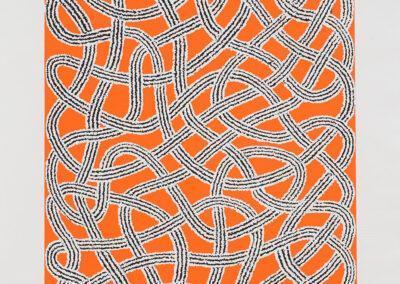
Ingeborg Lauterstein (b. 1923 Vienna, Austria; d. 2012 Rockport, MA), Portrait of Sewell Sillman, c. 1948-49. Oil on masonite. Courtesy of The Johnson Collection.
New Citizens: Exchanging Oppression for Freedom
After the Wake Up – Sherrill Roland
Over the last forty years, the United States has increased its prison and jail population by 500 percent. As an African American male, I am six times more likely to be incarcerated than white men. In prisons today, more than 60 percent of the population are people of color. Looking out across my housing unit in the District of Columbia’s Detention of Corrections, these statistics transformed into a visual that made the nightmare I was told abundantly clear.
After being wrongfully incarcerated, viewed as something other than my true self, and mistreated as a citizen by the criminal justice system—How do you think I will tell the story of the American Dream?
– Sherrill Roland
Homage to the Auction Block – Steve Locke
I am descended from the stolen and the enslaved-on both sides of my family. None came here willingly nor were they considered human-let alone citizens. They were stripped of country and forced to build a nation. In building America they built a home for me-the only home I have ever known.
Despite this nation doing everything it could to prove itself unworthy of their devotion (chattel slavery, the three-fifths compromise, the Missouri compromise, rise of the Klan, industrial slavery, debt peonage, Jim Crow, racial terrorism, segregation, redlining, voter supression, drug laws, mass incarceration) my ancestors fought and died to make America live up to its documents, its self-evident holdings, its promises. That fight is the responsibility of the citizen and my ancestors audaciously claimed the full rights of citizenship in the country they built. Even though claiming such could and did get them brutalized in body and spirit, they claimed nonetheless. That claim is my legacy.
Like my ancestors, I love this country. I know her full and bloody history, her crimes, and her mistakes and I love this country. I refuse to surrender my claims to the full citizenship for which my ancestors paid with their labor and lives. I continue to fight for the full rights of citizenship that are still denied to the descendants of the stolen.
A citizen reminds America what she has done and what she has left to do. A citizen knows what America owes and takes responsibility for what America has done in their name. A citizen knows that love requires the truth and that reconciliation requires justice.
I am a citizen of the United States despite so many attempts by others to remove that title from me.
It is a hard-won title that I will fight to keep.
– Steve Locke
Japanese American Internment – Nisei students at BMC
Correspondence between Black Mountain College and the War Relocation Authority, November 1942 Digital print from archival scan Western Regional Archive, State Archives of NC | Unknown photographer, Isaac “Ike” Nakata at Black Mountain College, ca. 1941. Digital print from scan. Western Regional Archive, State Archives of NC. | Isaac Nakata, Letter of application to Black Mountain College, May 1940. Digital print from scan. Western Regional Archive, State Archives of NC.
At the age of 16, Ruth Asawa and her family were sent to a Japanese American internment camp at the Santa Anita race track in Arcadia, California before transfer to The Rohwer Relocation Center in Arkansas. After eighteen months, she received a scholarship from a Quaker organization called the Japanese American Student Relocation Council to attend Milwaukee State Teachers College. Unable to complete her student teaching because of anti-Japanese sentiment, Ruth came to BMC where she studied under Josef Albers, Ilya Bolotowsky, Buckminster Fuller, and Merce Cunningham. After a trip to Mexico, Ruth began making the wire sculptures for which she is most known. She was deeply influenced by Josef Albers’ emphasis on process and materials. After BMC, Ruth settled in San Francisco with her husband Albert Lanier, an architecture student she met at the college. She received many public art commissions in California, including San Francisco Fountain at the Grand Hyatt on Union Square, the Mermaid Sculpture at Ghirardelli Square, and the Japanese-American Internment Memorial Sculpture at the Federal Building Plaza in San Jose. Ruth became an avid supporter of arts education in San Francisco and poured much of her energy into starting a public high school for the arts there. In 2010, the school was renamed for her and is now the Ruth Asawa San Francisco School of the Arts.













